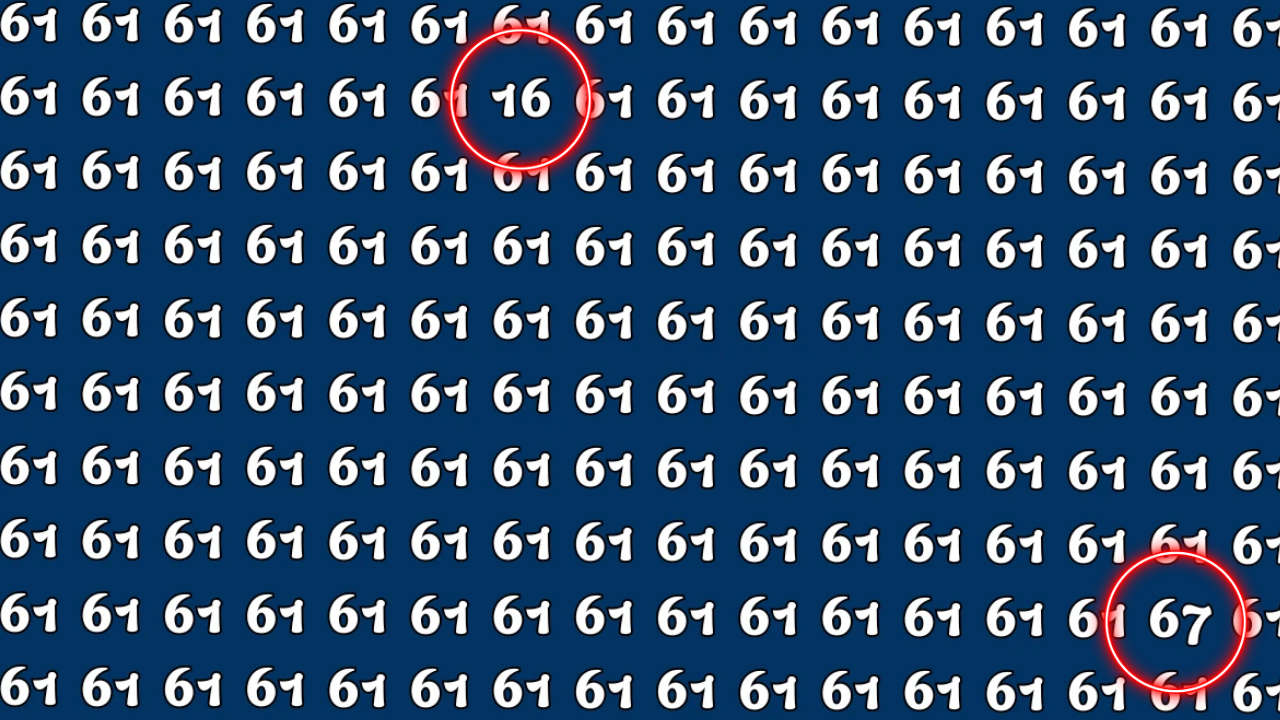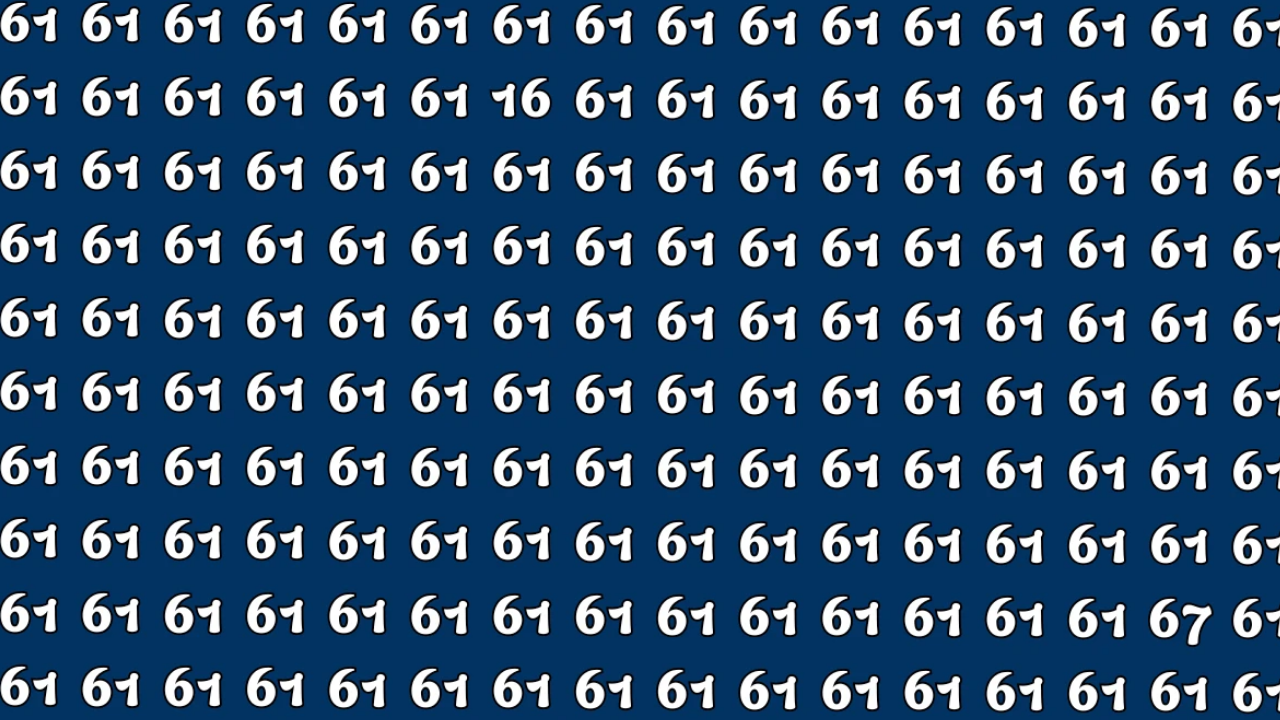Optical illusions are fascinating visual puzzles that challenge our perception and cognitive abilities. They trick the brain into seeing something that may not be immediately obvious, exploiting the way our visual system processes information. The challenge of spotting the numbers 16 and 67 hidden among a sea of 61s in just five seconds is a perfect example of an optical illusion that tests both speed and accuracy. This article delves into the science behind optical illusions, the specific challenge of finding 16 and 67, strategies to succeed, and the cognitive benefits of engaging with such brain teasers.
The Science Behind Optical Illusions
Optical illusions occur due to the complex interplay between our eyes and brain. The human visual system is designed to recognize patterns, fill in gaps, and make quick judgments about what we see. However, this efficiency can sometimes lead to misinterpretations. Illusions like the “spot the number” challenge exploit phenomena such as figure-ground organization, where the brain struggles to distinguish a target (like the numbers 16 or 67) from a repetitive background (a field of 61s).
The brain processes visual information in two primary ways: bottom-up processing, where raw visual data is analyzed, and top-down processing, where prior knowledge and expectations influence perception. In the case of this illusion, the repetitive pattern of 61s creates visual noise, making it harder for the brain to isolate the distinct numbers 16 and 67. The five-second time limit adds pressure, forcing the brain to rely on rapid pattern recognition rather than deliberate analysis.
The Challenge: Spotting 16 and 67 Among 61
Imagine a grid filled with the number 61 repeated multiple times, arranged in rows and columns. Somewhere within this grid, the numbers 16 and 67 are cleverly hidden, blending seamlessly with the surrounding 61s. The task is to locate both numbers within a mere five seconds. This challenge is deceptively simple but incredibly difficult due to the visual similarity between the numbers. The digits 1, 6, and 7 share visual characteristics (e.g., straight lines and curves), making it hard to differentiate them at a glance.
The time constraint of five seconds intensifies the difficulty. In such a short period, the brain cannot methodically scan every number. Instead, it must rely on quick visual sweeps and pattern-breaking cues to identify the outliers. The numbers 16 and 67 may be hidden in plain sight, but the repetitive nature of 61 creates a camouflage effect, tricking the eye into overlooking the differences.
Strategies to Succeed in the Challenge
To successfully spot 16 and 67 within five seconds, you need a strategic approach. Here are some effective techniques:
-
Focus on Pattern Disruption: Instead of reading each number individually, scan the grid for anything that breaks the visual monotony of 61. The numbers 16 and 67 will stand out if you train your eye to notice subtle differences in digit shapes.
-
Use Peripheral Vision: Central vision is excellent for detail but slow for scanning large areas. Use your peripheral vision to quickly sweep the grid, allowing your brain to pick up anomalies without focusing on each number.
-
Look for Unique Digits: The number 16 contains a unique digit (1 followed by 6), and 67 contains a 7, which has a distinct angular shape compared to the curves of 6 and 1. Train your eye to spot these differences.
-
Divide and Conquer: Mentally divide the grid into smaller sections and scan each one briefly. This reduces the overwhelming nature of the task and helps you focus on smaller areas.
-
Practice Rapid Recognition: Optical illusions improve with practice. The more you engage with similar challenges, the better your brain becomes at spotting outliers under time pressure.
-
Stay Calm Under Pressure: The five-second limit can induce panic, which impairs cognitive performance. Take a deep breath and approach the task with confidence, trusting your brain’s ability to process visual information quickly.
Why Optical Illusions Are Good for Your Brain
Engaging with optical illusions like this one offers numerous cognitive benefits. These puzzles are more than just fun; they stimulate the brain and enhance various mental skills:
-
Improved Visual Processing: Optical illusions train your brain to process visual information more efficiently, improving your ability to notice details and patterns in everyday life.
-
Enhanced Focus and Attention: The time constraint forces you to concentrate intensely, strengthening your attention span and ability to filter out distractions.
-
Boosted Problem-Solving Skills: Spotting hidden numbers requires quick thinking and strategic approaches, which enhance your problem-solving abilities.
-
Cognitive Flexibility: Illusions challenge your brain to switch between different modes of thinking, such as analytical and intuitive, fostering mental agility.
-
Stress Relief: While challenging, optical illusions are also enjoyable and provide a sense of accomplishment when solved, reducing stress and boosting mood.
The Psychology of Time Pressure
The five-second time limit is a critical component of this optical illusion. Time pressure influences how we process information, often pushing us to rely on heuristics (mental shortcuts) rather than deliberate analysis. In this case, the brain may initially perceive the grid as a uniform field of 61s, making it harder to notice 16 and 67. This phenomenon is known as “inattentional blindness,” where we fail to see something right in front of us because our attention is focused elsewhere.
Time pressure also activates the brain’s fight-or-flight response, releasing adrenaline and sharpening focus but potentially causing errors if panic sets in. Successful participants in this challenge learn to balance speed with accuracy, a skill that translates to real-world scenarios like decision-making under pressure.
Variations of the Challenge
The “spot 16 and 67 among 61” challenge is part of a broader category of optical illusions known as hidden object or number puzzles. Variations include:
-
Hidden Objects: Finding specific shapes or objects in a complex image, such as a hidden animal in a forest scene.
-
Word Search Puzzles: Locating specific words in a grid of letters, which tests similar pattern-recognition skills.
-
Color-Based Illusions: Spotting a different-colored item in a monochromatic field, relying on visual contrast rather than shape.
-
Motion Illusions: Identifying static objects that appear to move due to clever design, challenging the brain’s motion perception.
Each variation targets different aspects of visual and cognitive processing, making optical illusions a versatile tool for mental exercise.
How to Create Your Own Optical Illusion
If you’re inspired to create your own version of this challenge, here’s a simple guide:
-
Choose a Base Pattern: Select a repetitive number, letter, or shape as the background (e.g., 61).
-
Insert Hidden Elements: Place one or two distinct items (e.g., 16 and 67) within the pattern, ensuring they blend in visually.
-
Control Difficulty: Adjust the grid size, font style, or spacing to make the illusion easier or harder.
-
Add a Time Limit: Introduce a time constraint to increase the challenge and engage the brain’s rapid processing abilities.
-
Test and Refine: Try your illusion on others to ensure it’s challenging but solvable, tweaking as needed.
You can create digital versions using graphic design software or even simple tools like Microsoft Word or Excel to arrange numbers in a grid.
The Role of Optical Illusions in Education and Training
Optical illusions are increasingly used in educational and professional settings to enhance learning and performance. Teachers use them to engage students in critical thinking and visual literacy exercises. In professional training, illusions are employed to improve attention to detail, especially in fields like aviation, medicine, and design, where spotting small differences can be critical.
For example, pilots may use visual puzzles to sharpen their ability to identify objects in complex environments, while medical professionals practice spotting anomalies in scans or images. Optical illusions also foster teamwork when solved collaboratively, encouraging communication and strategy-sharing.

Tips for Mastering Optical Illusions
To become proficient at solving optical illusions, consider these tips:
-
Practice Regularly: Like any skill, visual perception improves with practice. Try different types of illusions to diversify your skills.
-
Study Visual Cues: Learn to recognize common techniques used in illusions, such as camouflage, contrast, or alignment.
-
Take Breaks: Prolonged focus can lead to visual fatigue, reducing accuracy. Step away briefly to refresh your eyes and brain.
-
Collaborate with Others: Sometimes, a fresh perspective from a friend can help you spot what you missed.
-
Use Technology: If allowed, tools like magnifying apps can help you zoom in on details, though this may reduce the challenge.
In Summary
The optical illusion challenge of spotting 16 and 67 among 61 in five seconds is a thrilling test of perception, speed, and mental agility. By understanding the science behind optical illusions, employing strategic techniques, and practicing regularly, you can improve your ability to conquer this and similar puzzles. Beyond the fun, these challenges offer significant cognitive benefits, from enhanced focus to improved problem-solving skills. So, the next time you encounter a grid of numbers, take a deep breath, trust your instincts, and see if you can beat the clock. Happy spotting!

